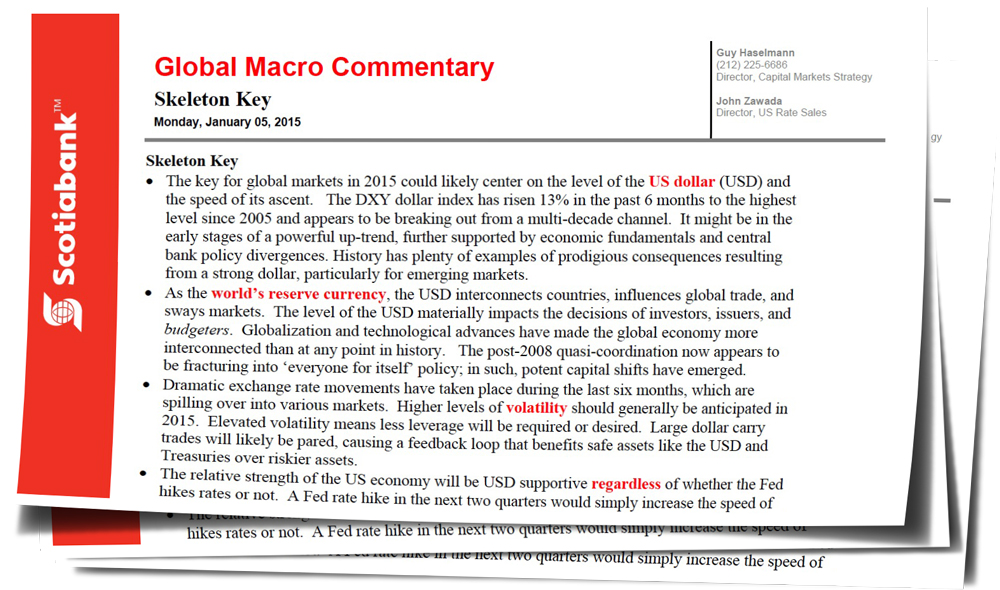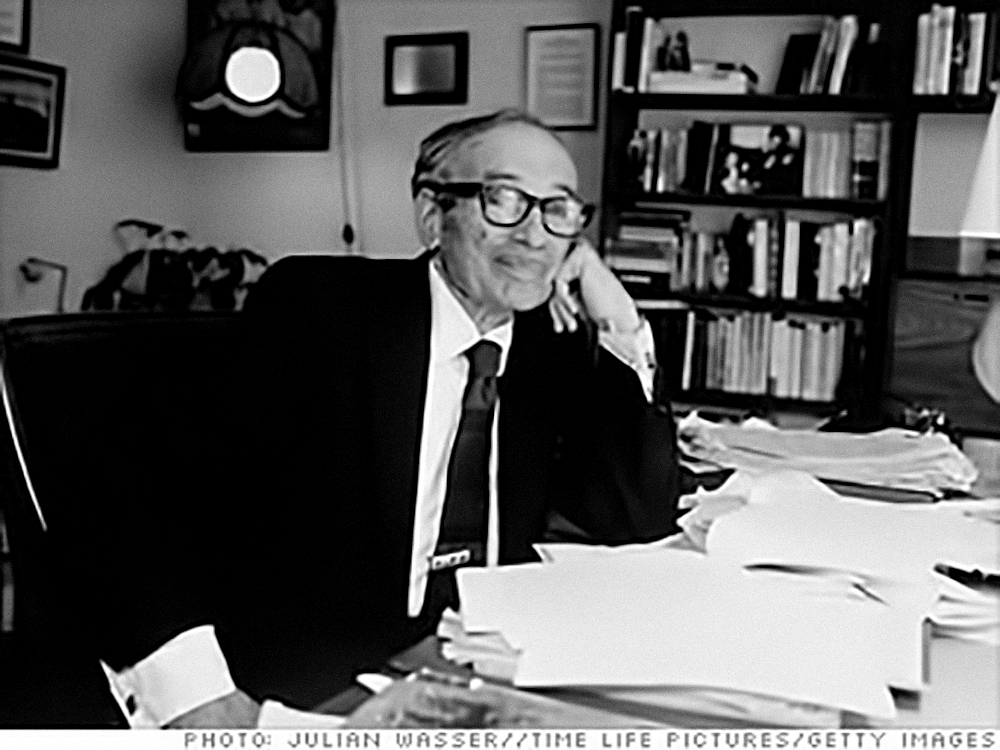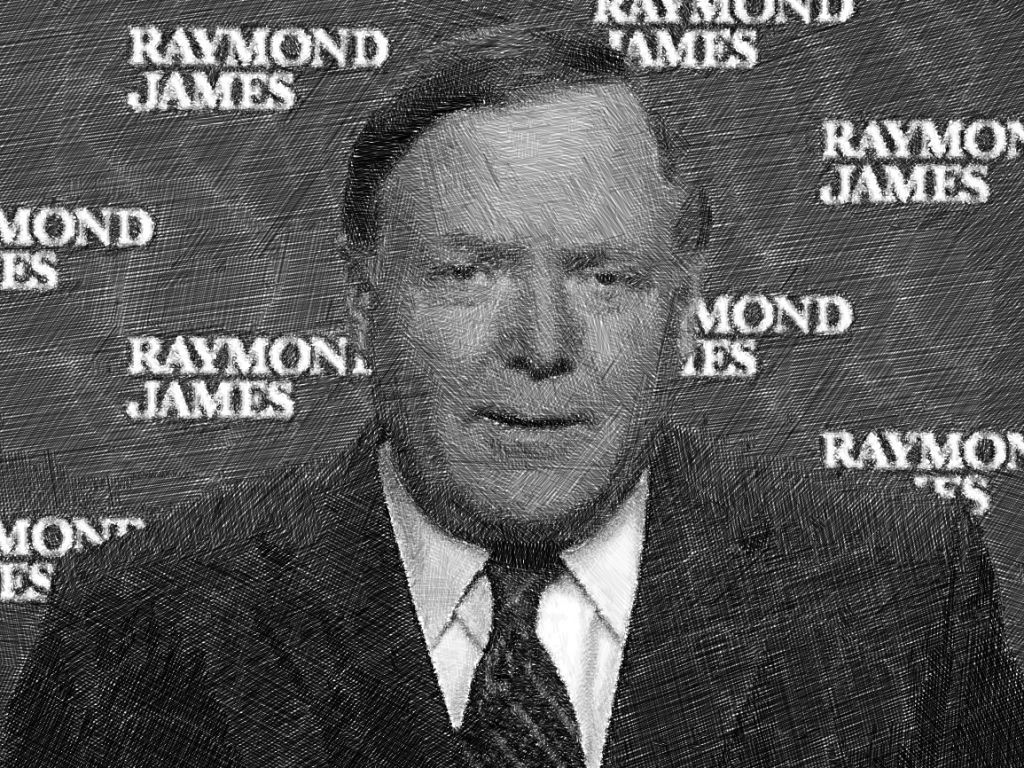Skeleton Key
by Guy Haselmann, Director, Capital Markets Strategy, Scotiabank GBM
· The key for global markets in 2015 could likely center on the level of the US dollar (USD) and the speed of its ascent. The DXY dollar index has risen 13% in the past 6 months to the highest level since 2005 and appears to be breaking out from a multi-decade channel. It might be in the early stages of a powerful up-trend, further supported by economic fundamentals and central bank policy divergences. History has plenty of examples of prodigious consequences resulting from a strong dollar, particularly for emerging markets.
· As the world’s reserve currency, the USD interconnects countries, influences global trade, and sways markets. The level of the USD materially impacts the decisions of investors, issuers, and budgeters. Globalization and technological advances have made the global economy more interconnected than at any point in history. The post-2008 quasi-coordination now appears to be fracturing into ‘everyone for itself’ policy; in such, potent capital shifts have emerged.
· Dramatic exchange rate movements have taken place during the last six months, which are spilling over into various markets. Higher levels of volatility should generally be anticipated in 2015. Elevated volatility means less leverage will be required or desired. Large dollar carry trades will likely be pared, causing a feedback loop that benefits safe assets like the USD and Treasuries over riskier assets.
· The relative strength of the US economy will be USD supportive regardless of whether the Fed hikes rates or not. A Fed rate hike in the next two quarters would simply increase the speed of the dollar rally and the speed of the Treasury yield curve flattening. Either way, the Fed will not be able to do much to stop the USD from appreciating. Nonetheless, it will be interesting to see what the Fed will do should headline inflation fall to, say, 0%, while core stays near 2%. To date, FOMC members have called the anticipated drop transitory and a benefit to the consumer.
· GDP growth in the US could be as strong today as it is going to get. Global levels of indebtedness are enormous. Collapsing ‘velocity of money’ is a symptom of extreme indebtedness. Fed policies have encouraged cheap issuance to spur growth today, but growing debt levels borrows from future growth.
· However, since US debt levels are trumped by those in Europe, Japan, and many other countries, the USD looks good on a relative basis. The shale revolution in the US (despite plunging oil prices) is shrinking the US current account deficit; thus, also acting to support the USD. On the other hand, a stronger dollar will hurt US competitiveness and exports over time.
· Over the past six years of the Fed’s zero interest rate policy, many countries and foreign corporations were also able to issue cheap debt in USD. An appreciating dollar increases those liabilities. Countries like China who have quasi-tied their currency to the USD, become less competitive with key trading
partners (Japan). Furthermore, any country dependent on commodity exports receives less revenue. Global headwinds are significant.
· The bottom line is that a stronger dollar is deflationary. QE provides market liquidity and can serve to temporarily boost asset prices, but it does little to create jobs or inflation. The biggest hurdle is too much debt, not the need for more cheap money. QE may also have sizable unintended consequences through rampant market speculation, herd-like investor behavior, and the creation of asset bubbles. Those potential ramifications have yet to be realized.
· The best investments or trades usually entail envisioning markets going to previously unforeseen levels and tying it to a coherent story line. Given the simple scenario outlined above, investors should become open minded to the potential for long-dated Treasuries continuing to rally. I can envision the10-year note trading to a new low yield (below 1.38%) and even below 1%. I expect the yield curve to flatten viciously this year. I remain a bond bull and believe the 30-year yield will trade with a ‘one handle’ (i.e.; below 2%) in 2015. I could even be right for different reasons.
· “How did I get lost, what’s the final cost? Could you please help me find the key?” – Black Stone Cherry
Regards and Happy New Year,
Guy
Guy Haselmann | Director, Capital Markets Strategy
▬▬▬▬▬▬▬▬▬▬▬▬▬▬▬▬▬▬▬▬▬▬▬▬▬▬▬
Scotiabank | Global Banking and Markets
250 Vesey Street | New York, NY 10281
T-212.225.6686 | C-917-325-5816
guy.haselmann[at]scotiabank.com
Scotiabank is a business name used by The Bank of Nova Scotia
Read/Download Guy Haselmann's complete report below:
















